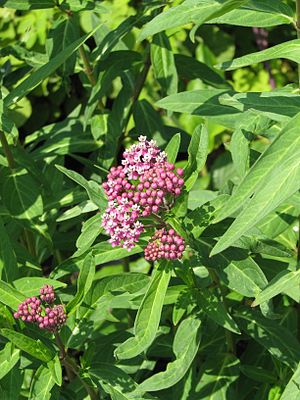Asclepias rubra
| Asclepias rubra | ||||||||||||
|---|---|---|---|---|---|---|---|---|---|---|---|---|

Asclepias rubra |
||||||||||||
| Systematics | ||||||||||||
|
||||||||||||
| Scientific name | ||||||||||||
| Asclepias rubra | ||||||||||||
| L. |
Asclepias rubra (English Red Milkweed, Red Silkweek , Tall Pink Bog Milkweed , Purple Savanna Milkweed and others) is a species of silk plants ( Asclepias ) from the subfamily of the silk plants (Asclepiadoideae).
features
Vegetative characteristics
Asclepias rubra is a perennial , herbaceous plant. The stems are slender, 40 to 100 cm high and unbranched. They are bald or rather inconspicuously tomentose, the felt runs in lines from the leaf axils down. The sessile leaves are broadly ovate to narrowly lanceolate. The apex of the blade is pointed, the base rounded to slightly heart-shaped. They are tight-skinned to leathery and 5 to 16 cm long and 1 to 6.5 cm wide. The top is dark green, the underside gray-green. The leaves are entire.
Inflorescence and flowers
The inflorescences are terminal or arise from the uppermost nodes. Terminal inflorescences are usually created in pairs, a total of one to four inflorescences are created. They are 3 to 5 cm in diameter and each contain a few to many flowers. The shafts are 3 to 10 cm long. The flowers are medium in size. The flower stalks are 1 to 1.5 cm long. The bare sepals are lanceolate-triangular and about 3 mm long. The crown is wheel-shaped with back curved petals . The petals are dull red, pink, lavender to purple and 8 to 9 mm long. The gynostegium is pedunculated with a cylindrical stalk about 2 mm high and wide. The secondary petals are lanceolate and pointed, about 6 to 7 mm long. They are cream with a pink tint or purple in color. The horn-shaped secondary process is needle-shaped and slightly shorter than the secondary corolla. They protrude beyond the ends of the petals and incline over the stylus head. The stylus head is narrow-conical and about 3 mm long and just as much wide. It has entire or only very slightly incised wings.
Fruits and seeds
The follicles stand upright on downwardly curved stems. They are thin-spindle-shaped, about 8 to 12 cm long and 1.5 cm thick. The bald outside is smooth. The seeds are broadly egg-shaped, about 7 mm long with a 4 cm long head of white hair.
Geographical distribution and ecology
The distribution area extends over the US states of Alabama, Delaware, Georgia, Louisiana, Maryland, New Jersey and Texas.
The plants grow there in bogs, swamps, damp meadows and low pine forests on sandy, nutrient-poor soils. The flowering period is from May to August.
Taxonomy and systematics
The species was first classified by Carl von Linné in 1753.
literature
- Robert E. Woodson, Jr .: The North American Species of Asclepias L. In: Annals of the Missouri Botanical Garden , Vol. 41, No. 1, 1954, pp. 1-211, St. Louis, Mo. URL , pp. 80-81.
Individual evidence
- ^ Nathaniel Lord Britton, Addison Brown: An Illustrated Flora of the Northern United States, Canada and the British Possessions. 2nd edition, New York, 1913
- ↑ Jason Singhurst, Ben Hutchins: Identification of Milkweeds in Texas. Texas Parks and Wildlife Department, 2015, p. 28 PDF
- ↑ Henning VonSchmeling: Field Guide to Georgia Milkweeds. PDF ( Memento of the original from November 7, 2017 in the Internet Archive ) Info: The archive link has been inserted automatically and has not yet been checked. Please check the original and archive link according to the instructions and then remove this notice.
- ↑ Carl von Linné: Species Plantarum. Tomus I. Laurentius Salvius, Stockholm, 1753 Online at www.biodiversitylibrary.org (p. 217)

